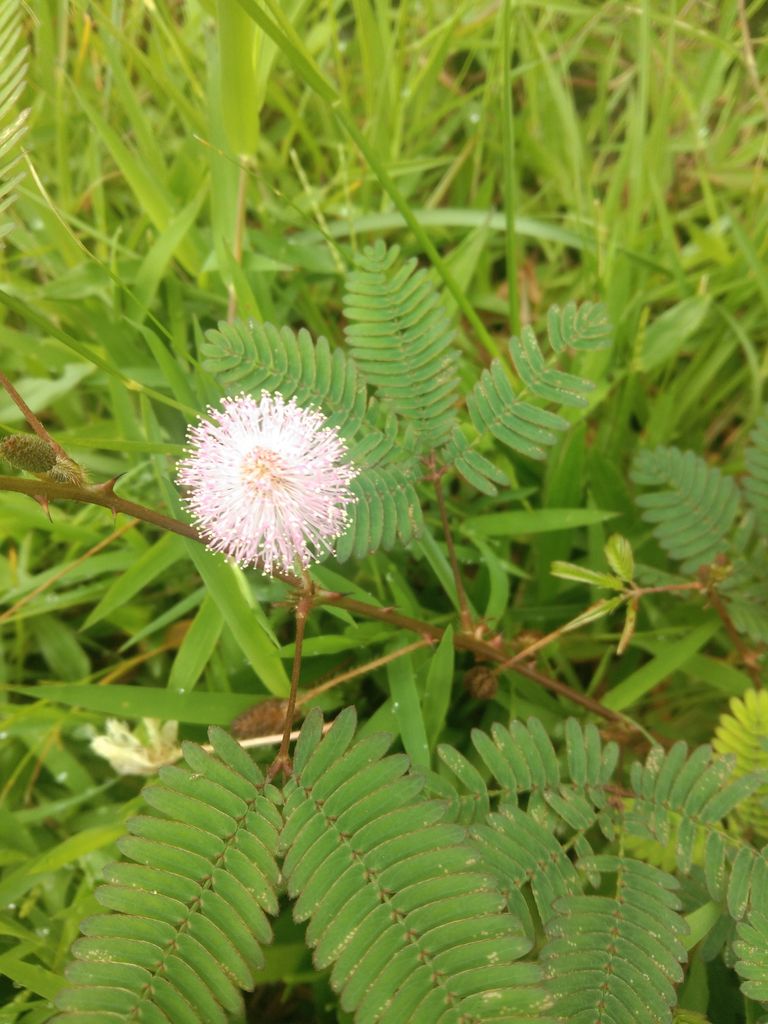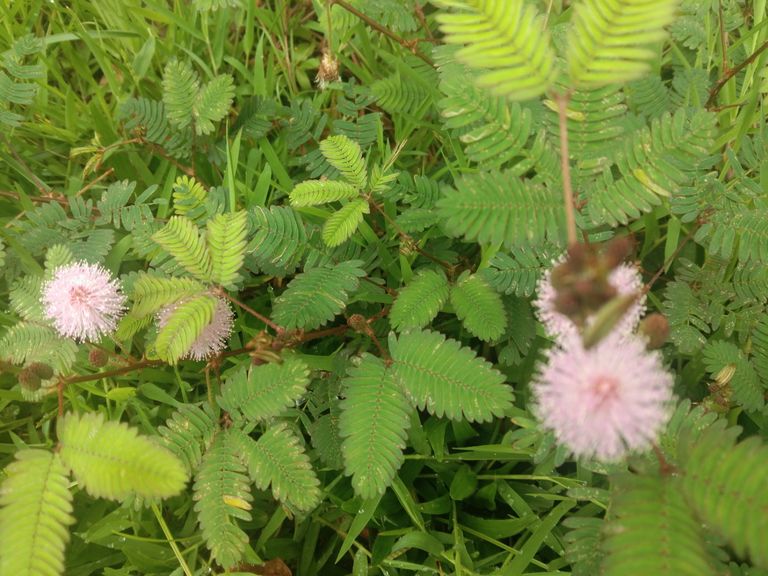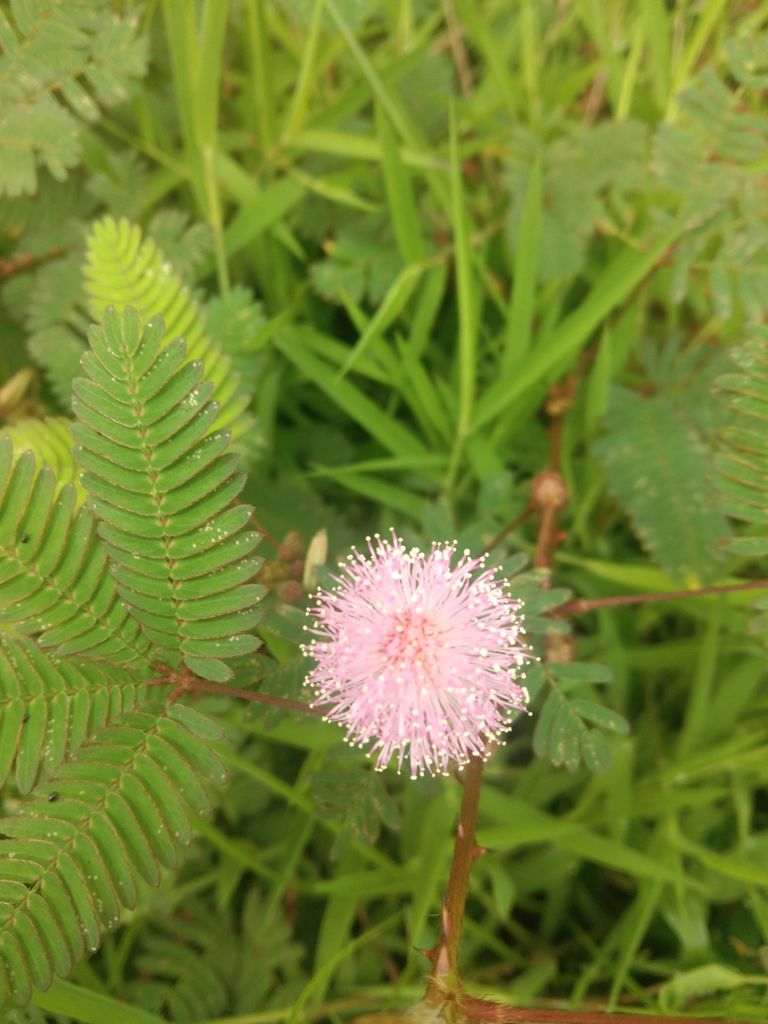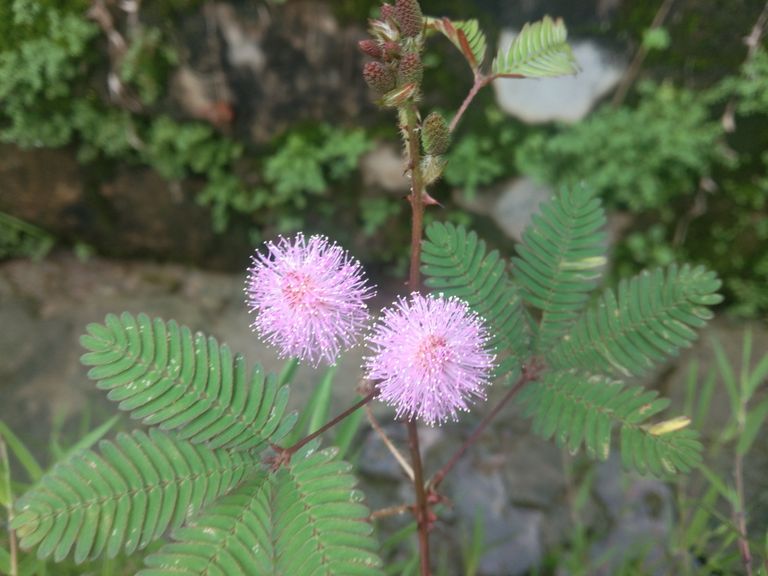Hello Blurtters,
Today I’m going to share you five photos of beautiful Mimosa pudica flowers that I took using the camera of a smartphone. Hope you like it.





Cheers,
Larasbpn

Mimosa pudica was first formally described by Carl Linnaeus in Species Plantarum in 1753. The species epithet, pudica, is Latin for "bashful" or "shrinking", alluding to its shrinking reaction to contact.
The species is known by numerous common names including sensitive plant, humble plant, shameplant, and touch-me-not.
The stem is erect in young plants but becomes creeping or trailing with age. It can hang very low and become floppy. The stem is slender, branching, and sparsely to densely prickly, growing to a length of 1.5 m (5 ft).
The leaves are bipinnately compound, with one or two pinnae pairs, and 10–26 leaflets per pinna. The petioles are also prickly. Pedunculate (stalked) pale pink or purple flower heads arise from the leaf axils in mid-summer with more and more flowers as the plant gets older. The globose to ovoid heads are 8–10 mm (0.3–0.4 in) in diameter (excluding the stamens). On close examination, it is seen that the floret petals are red in their upper part and the filaments are pink to lavender. Pollens are circular with approximately 8 microns in diameter.
Pollens
The fruit consists of clusters of two to eight pods from 1–2 cm (0.4–0.8 in) long each, these being prickly on the margins. The pods break into two to five segments and contain pale brown seeds about 2.5 mm (0.1 in) long. The flowers are insect-pollinated and wind-pollinated. The seeds have hard seed coats which restrict germination and make osmotic pressure and soil acidity less significant hindrances. High temperatures are the main stimuli that cause the seeds to end dormancy.
The roots of Mimosa pudica create carbon disulfide, which prevents certain pathogenic and mycorrhizal fungi from growing within the plant's rhizosphere. This allows the formation of nodules on the roots of the plant that contain endosymbiotic diazotrophs, which fix atmospheric nitrogen and convert it into a form that is usable by the plant.
Mimosa pudica is native to the tropical Americas. It can also be found in Asian countries such as Singapore, Bangladesh, Thailand, India, Nepal, Indonesia, Taiwan, Malaysia, the Philippines, Vietnam, Cambodia, Laos, Japan, and Sri Lanka. It has been introduced to many other regions and is regarded as an invasive species in Tanzania, South and Southeast Asia, and many Pacific islands. It is regarded as invasive in parts of Australia and is a declared weed in the Northern Territory, and Western Australia although not naturalized there. Control is recommended in Queensland.
It has also been introduced to Uganda, Ghana, Nigeria, Seychelles, Mauritius and East Asia but is not regarded as invasive in those places. In the United States, it grows in Louisiana, Florida, Hawaii, Tennessee, Virginia, Maryland, Puerto Rico, Texas, Alabama, Mississippi, North Carolina, Georgia, the territory of Guam, and the Virgin Islands
Mimosa pudica atau yang kita kenal dengan sebutan Putri Malu adalah perdu pendek anggota suku polong-polongan yang mudah dikenal karena daun-daunnya yang dapat secara cepat menutup/layu dengan sendirinya saat disentuh. Walaupun sejumlah anggota polong-polongan dapat melakukan hal yang sama, putri malu bereaksi lebih cepat daripada jenis lainnya. Kelayuan ini bersifat sementara karena setelah beberapa menit keadaannya akan pulih seperti semula.
Keunikan dari tanaman ini adalah bila daunnya disentuh, ditiup, atau dipanaskan akan segera "menutup". Hal ini disebabkan oleh terjadinya perubahan tekanan turgor pada tulang daun. Rangsang tersebut juga bisa dirasakan daun lain yang tidak ikut tersentuh.
Gerak ini disebut seismonasti, yang walaupun dipengaruhi rangsang sentuhan (seismonasti), sebagai contoh, gerakan seismonasti daun putri malu tidak peduli dari mana arah datangnya sentuhan.
Tanaman ini juga menguncup saat matahari terbenam dan merekah kembali setelah matahari terbit.
Tanaman putri malu menutup daunnya untuk melindungi diri dari hewan pemakan tumbuhan (herbivora) yang ingin memakannya. Warna daun bagian bawah tanaman putri malu berwarna lebih pucat, dengan menunjukkan warna yang pucat, hewan yang tadinya ingin memakan tumbuhan ini akan berpikir bahwa tumbuhan tersebut telah layu dan menjadi tidak berminat lagi untuk memakannya.
** Your post has been upvoted (4.87 %) **
Curation Trail is Open!
Join Trail Here
Delegate more BP for bigger Upvote + Daily BLURT 😉
Delegate BP Here
Upvote
https://blurtblock.herokuapp.com/blurt/upvote
Thank you 🙂 @tomoyan